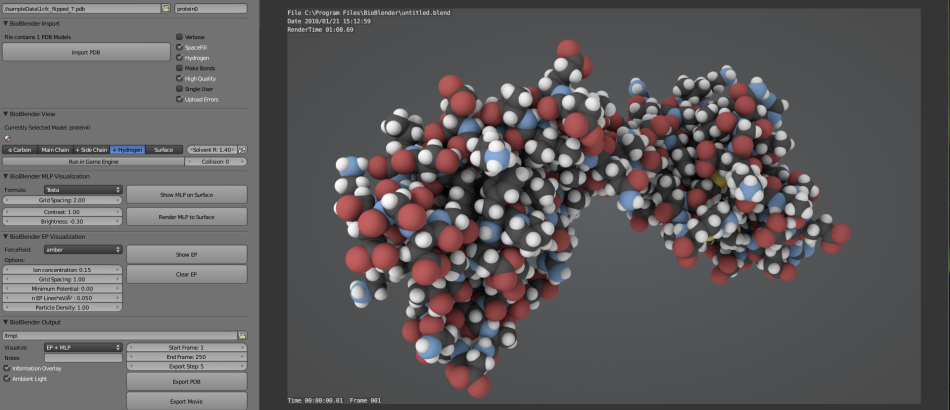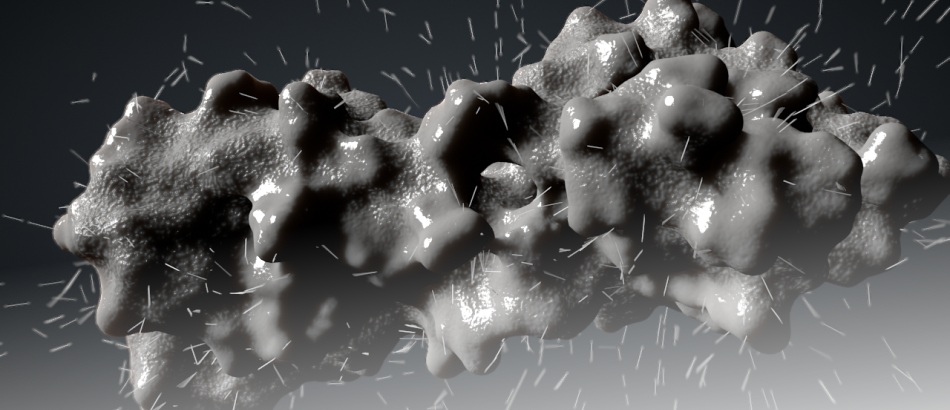The BioBlender project is dicontinued.
I thank all the people that have contributed to it in the 15 years of its existence, including the users that helped to test it and to keep it somehow alive for the latest period.
In particular my gratitude goes to the group that initially developed it (in Blender 1.5!), in the SciVis group and the Blender Community.
The page will remain active for some time, but the program will not be updated.
There are two main reasons for closing: on one side, BB was developed 15 years ago, and its structure is hardly compatible with the new Blender versions, especially since we have no funding for updating it regularly. On the other side, the new ‘Node Everything’ structure of Blender have made it possible to introduce and elaborate structural biology models in a much more efficient way, as demonstrated by the great work by Brady A Johnston, that the Blender users already adopted.
I hope that some legacy from BioBlender will survive, especially the concept of decorating the molecules with their physico-chemical properties, which are (in my biased opinion) still unsurpassed as visual effects, even if too cumbersome to calculate and display.
Thanks again to all,
Written on January 20th, 2023.
The code was heavily revisited and adapted to Blender 2.93, in which, luckily, they re-introduced the Texture painting feature for the MLP. This is now organized in nodes, so one can adjust some visual details for visualization of the lipophilic potential of the molecules.
The Electrostatic potential is now represented with a different trick: we could not use particles flowing along the potential lines, so we made the lines as objects (cylinders), and painted them with a texture that alternates alpha and a white emitter. If you don’t see them in render, try increasing the size of the cylinders.
The Game engine has been dismissed, but there are voices that the Blender team is working to bring it back within Blender, which will be great (when it happens!).
Download it from GitHub https://github.com/PabloEnmanuelRamos/BioBlender21/releases/download/v1.0/BioBlender-master.zip
Please test and let us know of any results (things working well or not working)
Written on July 13th, 2021.
Hallo Everyone.
As announced, we are working to make BioBlender available for Blender 2.8 series (and after).
The work is much more engaging than we thought, and we are still on it. Nevertheless, some parts are working, and since many of you have requested it, we are making available the working version.
Please note that when we say we it means myself (a biologist, not a programmer) and Pablo, a very talented but young student of bioinformatics, that is dedicating much of his time to the project. If any of you is willing to contribute, any help will be warmly welcome!
The BB present and not finished version can be downloaded from here (see the 19/11/2020 update)
Known issues:
1 – Visualization: it works in our hands. Let us know if you have problems
2 – MLP here we have some problems: it is calculated but not displayed. Want to help? Write to us! (but be aware: it is complicated)
3 – EP: same as the MLP: it is calculated, and imported in the Blednde 3D scene, but is not renrdered
4 – Game Engine simulation: not possible
5 – Output: both are available as features, but, of course, make no sense since there are no new PDB to be exported, and the movies will not show conformational changes, nor EP or MLP.
19/11/2020 update – BioBlender for 2.8 bug fix
Please download the latest BB version form here (link). It contains some minor fixes. Please be aware that many functions are still not working.
Sorry! (Let us know if you can/want to help)
Written on October 19th, 2020.
We are working! Please note that the latest version of BioBlender is always the one releases on GitHub. (clicl on the green CODE button and download the zipped file)
Since the last release, we have fixed several minor issues, related to :
MLP calulation on surface and storage of data
EP calculation and handling of Field lines
Movie Export with EP and MLP surface
Also the Manual has been updated with some suggestions for a better use of BioBlender
We are also actively working to the version for Blender 2.8.
Drop us a line if you are willing to collaborate!
Written on July 2nd, 2020.
BUG FIX. Get the latest version: there was a bug in the MLP rendering, now fixed. Find it on GitHub or here.
We are pleased to announce that the new version BioBlender 2.1 is now available for download from GitHub or here from the BioBlender website.
The packet has been tested and works as an AddOn on Blender version 2.79b. We are now working to update to the latest Blender. We invite all interested users to download and use it, and to report any issues on the dedicated page on GitHub or via mail to monica.zoppe at cnr.it.
You can download the Manual in English here.
Together with the update, we intend to also extend BioBlender capabilities, so if you have any request, just let us know.
We look forward to your feedback.
Written on April 21st, 2020.
BioBlender is now an Open Program. You can find it on GitHub at this page.
Please note that the program is not fully functioning: if you are a programmer please check it out and help to fix it.
Thanks
SciVis team
Written on February 2nd, 2015.

We are pleased to provide the new BioBlender, version 1.0, for Windows and Linux.
Please note that this version is an Addon to be uploaded into the current version of Blender, as detailed in the ReadMe file.
We have tested it with several molecules, but of course there might be details that we have overlooked. You are welcome to send us any comment, writing to the address in the ReadMe file.
Thanks for using BioBlender
SciVis team
Notice to BioBlender users (05-march-2014).
Version 1.0 has been demonstrated inadequate in two major features of the program.
It cannot import proteins of medium to large size, and cannot calculate MLP. For this reason we have withdrawn it, while we look for solutions to the problems.
Apologies to all.
If you wish to be notified of new release, please send a mail to info@scivis.it
If you have programming skills, and wish to contribute voluntarily to solving these problems, we are happy to hear from you.
Written on March 5th, 2014.

We release BioBlender v 0.6, made in collaboration with Nicolas Ferèy who integrated the calculation of proteins trajectories using Normal Mode Analysis (as calculated by ProDy package). Please download ProDy from here (our tests were done using 0.8.3 version) and install it on your computers.
What’s new
- Better calculation for Game Engine: adjusted settings for the rigid body.
- New Normal Mode Analysis import: BioBlender can now elaborate data from ProDy. Please refer to ProDy page for information on settings.
Minor adjustments:
- Default keyframe interval is now 100 frames. Interpolation is much better
- Longer and less bright particles for EP visualization
- Alpha Carbon view has been removed
How to use NMA in BioBlender
To perform NMA, select a .pdb file without importing it in the BB scene. Set NMA options and calculate PDBs, set the Keyframe Interval (default is 100 and the motion is very slow) and press Import PDB button.
WARNING
Please note that version 0.6 of BioBlender is operating properly only on Linux system.
We are working to update the program for Windows, and to adapt it to the latest version of Blender.
Download:
BioBlender 0.6 for Windows
BioBlender 0.6 for MacOS
BioBlender 0.6 for Linux
Written on November 14th, 2011.
We have finally managed to set up BioBlender for Linux and Mac users!
You can download the two packages below.
Please let us know of any problem you meet using this program.
MacOS version
Linux version
Written on October 17th, 2011.
This tutorial shows how to make your 3D Interactive visualization using the template folder. Please visit SciVis website for more information and examples.
Written on August 3rd, 2011.


